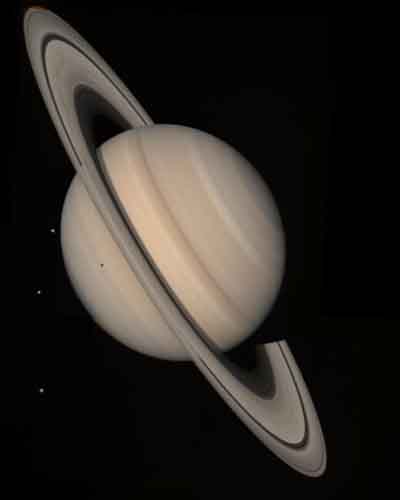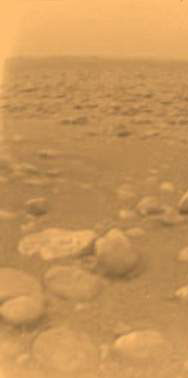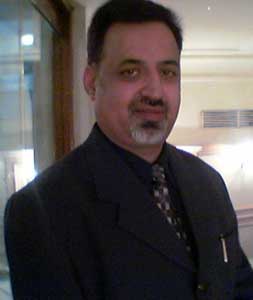|
|
|
|

SATURN SATURN The Ringed Planet, is probably the most visually stunning planet in our planetary neighborhood. Saturn's giant rings are actually made of of thousands of small particles of dust and ice. The divisions in the rings we see from Earth are caused by some of Saturn's smaller moons. |
|
Saturn is the most distant of the five planets known to ancient stargazers. In 1610, Italian Galileo Galilei was the first astronomer to gaze at Saturn through a telescope. To his surprise, he saw a pair of objects on either side of the planet, which he later drew as "cup handles" attached to the planet on each side. In 1659, Dutch astronomer Christiaan Huygens announced that this was a ring encircling the planet. In 1675, Italian-born astronomer Jean Dominique Cassini discovered a gap between what are now called the A and B rings Saturn is the sixth planet in the solar system, located in between Jupiter and Uranus. Saturn is much further away from the Sun than we are here on Earth. Its average distance from the Sun is over 850 million miles, compared to Earth's which is 93 million miles. Saturn's orbit, the path it follows around the Sun, is nearly a circle. The closest the as planet comes to the Sun is around 840 million miles, while the furthest away it gets is around 930 million miles. Since Saturn is so far away from the Sun, it takes a very long time for it to go around the Sun once. A year on Saturn, the amount of time it takes for this trip, is twenty-nine and one-half Earth years! A day on Saturn, though is much shorter than one of our Earth days. The giant planet spins around, or rotates, once every ten and one-half hours. Can I See It?
How Big Is
It?
What About
the Rings?
How Many Moons
Does It Have?
How Did It
Get Its Name?
What's It Made
Of?
|

TITAN
The data was sent to NASA's Cassini spacecraft, and was recorded and relayed through NASA's Deep Space Network to the Jet Propulsion Laboratory, Pasadena, Calif., and to ESA's Space Operations Center in Darmstadt, Germany. The European Space Agency facility is the operations center for the Huygens probe mission. Data was received over one of two channels designed to be mostly redundant. JPL Director Dr. Charles Elachi said, "We congratulate our colleagues at ESA on the splendid performance of the Huygens probe and look forward to the science results of this effort. This has been a great example of international collaboration to explore our solar system." Cassini-Huygens is a joint mission of NASA, ESA and the Italian Space Agency. ESA's Huygens probe was carried to Saturn's orbit aboard Cassini, and sent on its way to Titan on Dec. 24, 2004. Cassini continues to orbit Saturn on a four-year prime mission to study the planet, its rings, moons and magnetosphere. "Our ESA colleagues have every reason to be very proud of the excellent manner in which the Huygens probe performed," said Robert T. Mitchell, Cassini program manager at JPL. "We are also proud of our support for this endeavor," he said. JPL, a division of the California Institute of Technology in Pasadena, manages the Cassini mission for NASA's Science Mission Directorate, Washington. JPL designed, developed and assembled the Cassini orbiter. ESA built and managed the development of the Huygens probe and is in charge of the probe operations. ISA provided the high-gain antenna, much of the radio system and elements of several of Cassini's science instruments. This is of the first pictures
returned by the European Space Agency's
A colored view of the moon's
surface shows pebble-sized objects originally
|
|
|
|
|
|
|
|
|
|
|
|

Welcome to Rajesh Chopra's Guest Book and comments Please |

|
All rights reserved. No part of this publication and other sites of under liveindia.com may be transmitted or reproduced in any form or by any means without prior permission from the publisher Live India Internet Services or Rajesh Chopra, L.C.Premium Cables, 1826, Amar Nath 2nd Building, Bhagirath Palace Delhi - 110006, India. Liveindia.com or Mr.Rajesh Chopra is not responsible for any wrong information under this site, For confirmation of any information it is recommended that you can reconfirm from yours end |
 |